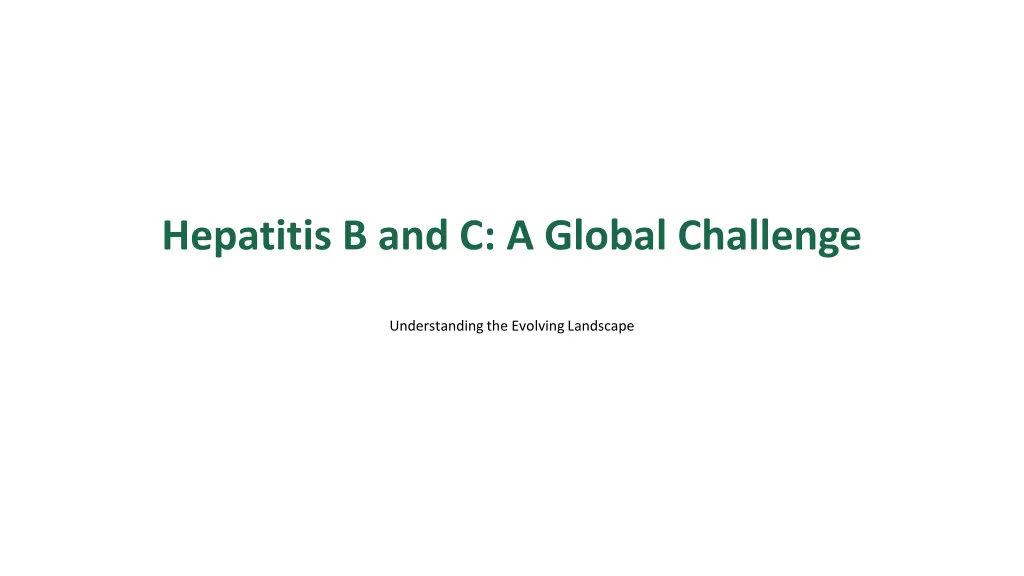
Understanding the Global Challenge of Hepatitis B and C
"Explore the evolving landscape of Hepatitis B and C with insights into control measures, guidelines for management, and strategies to overcome challenges. Learn about the current scenario, raising awareness, and the importance of global efforts in combating Hepatitis infections."
Download Presentation

Please find below an Image/Link to download the presentation.
The content on the website is provided AS IS for your information and personal use only. It may not be sold, licensed, or shared on other websites without obtaining consent from the author. If you encounter any issues during the download, it is possible that the publisher has removed the file from their server.
You are allowed to download the files provided on this website for personal or commercial use, subject to the condition that they are used lawfully. All files are the property of their respective owners.
The content on the website is provided AS IS for your information and personal use only. It may not be sold, licensed, or shared on other websites without obtaining consent from the author.
E N D
Presentation Transcript
Hepatitis B and C: A Global Challenge Understanding the Evolving Landscape
01 The Evolving Landscape of Hepatitis B and C Table of Contents 02 Control Measures in Action 03 Guidelines and Recommendations for Management 04 Navigating Challenges and Developing Strategies 05 Current Scenario in India 06 Overcoming Challenges: The Path Forward 07 Thank You! Together We Can Make a Difference
1 The Evolving Landscape of Hepatitis B and C Hepatitis B and C remain significant public health issues worldwide, with changing patterns in prevalence and transmission. The rise in risk factors such as intravenous drug use and unregulated healthcare practices are key contributors to the changing epidemiology. Awareness and education are critical in addressing these shifting patterns, encouraging communities to engage actively in prevention and care. Global efforts are necessary to understand local variations in the epidemiology of Hepatitis B and C, ensuring targeted interventions. Engaging communities can foster a collective response to combat the rising trends in Hepatitis infections.
2 Control Measures in Action Control measures are pivotal in reducing the burdenof Hepatitis B and C globally. Vaccination for Hepatitis B is one of the most effective control strategies, significantly decreasing transmission rates. Increased screening and early detection can lead to timely treatment and care, reducing the risk of chronic infection and transmission. Harm reduction strategies for at-risk populations, including needle exchange programs, can minimize the spread of Hepatitis C. Public policy and legislation play an essential role in implementing and sustaining these control measures.
3 Guidelines and Recommendations for Management Global health organizations provideclear guidelines for the diagnosis and management of Hepatitis B and C. Early diagnosis through screening is paramount; hence, regular testing should be promoted in high-risk populations. Effective antiviral treatments for both Hepatitis B and C can lead to viral suppression and improved quality of life. Patient management guidelines must be accessible and tailored to local contexts for optimum implementation. Continuous training for healthcare providers on updated protocols can enhance care delivery.
4 Navigating Challenges and Developing Strategies Despite advancements, challenges remain in addressing Hepatitis B and C, including stigma and lack of awareness. Access to healthcare and treatmentvaries dramatically, often leaving marginalizedpopulations underserved. Integrating Hepatitis services within broaderhealth initiatives can improve access and reduce stigma. Collaboration with community organizations can enhance outreach and education, fostering a supportive environment. Innovative strategies, including telemedicine, can bridge gaps in healthcare access.
5 Current Scenario in India India is witnessing a significant burdenof Hepatitis B and C, with millions affected by these viruses. Awareness campaigns are increasing, yet many still lack knowledge about transmission and prevention. Government efforts, including the National Viral Hepatitis Control Program, aim to reduce prevalence and improve management. Improving testing rates and access to antiviral treatment remains a priority for public health officials. Data-driveninterventions are essential to address the unique challenges posed by the Indian context.
6 Overcoming Challenges: The Path Forward Addressing the challenges of Hepatitis B and C requires innovative and comprehensive measures. Public awareness campaigns need to be more widespread, targeting misconceptions and stigma associated with these infections. Strengthening healthcare infrastructure to ensure adequate testing and treatment resources is crucial. Engaging with communities to promote local leadership in Hepatitis management can create sustainable change. Partnerships across sectors can facilitate resource sharing and enhance the overall response to these public health challenges.
7 Thank You! Together We Can Make a Difference Your engagement and awareness about Hepatitis B and C can drive change in your community. Together, we can create a world where these viral infections are no longer a public health issue. Let us work collectively to implement effective strategies and support those affected. Thank you for your attention and commitment to this vital cause! Let's initiate conversations and actions towards a healthier future.
